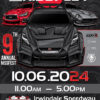Everyone starts somewhere different. In our case, we started with an offer for a S85B50 V10 that had developed the well-known “rod knock” issue. Without hesitation, we took the offer and began with the very first steps of building something fun and worthwhile. After browsing the internet for about 2-3 weeks, we came across a clean title E46 coupe shell for the astronomical sum of $200. PERFECT!!! After we dropped the oil pan on the S85 we did find some damage…but luckily nothing to do with the rods. Still unfortunate, we learned that the secondary oil pump had failed and seized the motor.
Tear down of the rolling chassis began the following morning, and although the car was already pretty bare, there was still plenty of clean up work to get it ready for the first first steps of fabrication. We already had all the essential M3 suspension components, including the rear carriage and differential. We removed every single wire and cleaned up all of the factory sound deadening, which, by the way, required its own special level of patience.
GTR Build Essentials
Now we have a motor that needs parts and rebuilding and we have a chassis that needs an impossible-to-source body kit. So where do we start? The motor seemed to be the most logical place. Much of the engine needed refinishing and that meant throwing a smattering of brand new parts into all ten cylinders. We chose to replace the entire valvetrain, replace the rod bearings, refinish the crankshaft, refresh the heads, and…..delete the VANOS? The decision to delete the VANOS was in order to make this car as reliable of a track car as possible. Much of the S85’s VANOS components are expensive and prone to failure, so we figured we’d make them a non-issue. As the car would have a custom wiring harness and ECU solution, tuning would not be an issue. We mated the motor to a 6 speed manual gearbox from an E9X M3, as well as a fresh S85 clutch and flywheels.
Visions of greatness
You would be hard-pressed to find a car fanatic that doesn’t know the E46 M3 GTR. The wide, P60B40 V8 dominated ALMS in the 2001 and was so fast that it was banned outright only a year after its inception after failing to meet homologation requirements. It was still campaigned internationally through much of the early 2000s in other series. The car was also the cover of Need For Speed: Most Wanted. Needless to say, the M3 GTR had a massive reputation, backed by its staggering presence. With this in mind, we decided that we would have to pay proper tribute to the original chassis that captured out hearts. The PTG spec 9/11 livery car is one of our favorites, with its distinctive red, white and blue livery. Unfortunately, it is all but impossible to acquire the original body kit that those cars featured and we felt that none of the other kits on the market accurately recreated that look. No matter though, we’d just have make our own…from scratch…with nothing to go off but pictures. Doesn’t sound too hard right?
Well it is. There is a lot that goes in to building a body kit by hand, so we decided to start from the wheels out. We purchased a set of BBS E29 centerlock faces from a Porsche GT3 Cup. Here’s where things got tricky. After a lot of consideration, we decided that we would pursue a 5-lug mounting solution rather than the original centerlocks, as we felt the stud and nut option was more reliable and livable in the real world. Instead of discarding our beautiful race wheels, we opted to send them out and have them carefully redrilled to a 5×120 bolt pattern, all while taking into consideration the effort that BBS had undergone to maintain significant weight savings on the backpads. We then sourced lips and barrels so that we could run 10 and 11 inch wheels for the front and rear, respectively. The 18 inch E29s have optimum backspacing and barrel clearance to fit the new Brembo GT 6-pot calipers and a 345mm two-piece floating rotors, perfect for bringing a 500+ horsepower track car to a halt.
From the ground up
Once we found an appropriate wheel and tire size for our build, we started forming the flares around the newly widened track. Using a myriad of detailed images that we had gathered from the PTG M3 GTR, we began with a foam base and started to shape the flares around the massive tires. With a 285 in the front and a tall 305 R-Compound in the back, the signature flares of the M3 GTR came to vision. We took care to utilize the factory fenders and bumpers while building the kit, so that mounting them to another car would be as effortless as possible, while also conforming to the accuracy of the PTG kit as best as we could. We also took care to improve on what we found to be some shortcomings in the original factory kit. Most of these were just nitpicks with the fitment and symmetry of the original kit that we noticed.
After creating a rough shape out of foam, we used fiberglass and resin to create a mold of the flares. The front fenders were sent out with the flares, to make the fenders fit as accurate to OEM as possible. The flares are roughly 60mm wider than the stock car on each side, allowing you to push the track width far out and easily run wide wheel and tire setups without any worry of interference from suspension or the body.
Replace Everything
Simplify, Add Lightness
Quite a few things differentiate the factory E46 from the PTG racecars. Much of the weight-reduction on the race cars comes from shaving the brackets and mounting points that much of the original interior mounts to. The original wiring harness also contained a significant amount of extra electrical connectors for the factory auxiliary components like speakers and lights. All of this would be scrapped, as it is completely unneeded for a race build. We had a custom engine harness fabricated, and ran simple wiring and relays for the turn signals and lighting . We also opted to cut out the factory battery box and spare tire tray, replacing them with light weight aluminum plates. We also cut out the entire rear seat and deck area, which proved to be a substantial amount of weight. The factory doors were completely gutted of their internals, and the maximum amount of material was shaved from them without sacrificing their original usability and structure.
With all this cutting and shaving, we decided that we needed to do everything the proper way. In proper motorsports spirit, we took the factory dashboard and replicated it in beautifully woven carbon fiber. Weighing in at 6 pounds, and fully customizable, the carbon fiber dash is a true race-inspired piece. This is a huge advancement for the E46, as there are no other available aftermarket dashes that accept the factory trim or mount to the factory locations. The dash fits amazingly, and will accept the center factory vents and cluster with some modification.
Safety first
Exhausting work
Taking Shape
Getting the pieces ready for the mold process is one of the most difficult parts of the entire process. Many hundreds, maybe even thousands of hours were spent refining the edges, symmetry, level and overall fit and finish of the kit. Without much to go on other than pictures, many areas were done and then redone to achieve the best possible results. We are aware that parts of the kit are…. polarizing…. to say the least, but for the sake of accuracy we retained even the strangest of features. We decided it best to leave some of the features off of the final product, most notably the cut panels on the back side of both front and rear flares. These can be easily be cut added in post if desired, but are designed to increase or decrease flow within the fender for aerodynamic and cooling purposes as desired. Overall fitment is tight and as close to OEM as possible. for a full widebody kit.
Heart of the Beast
Inside The Cage
A Heart of Gold
Maximum Downforce



